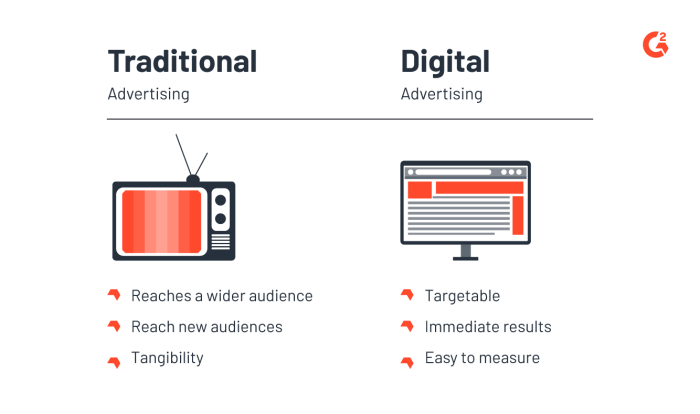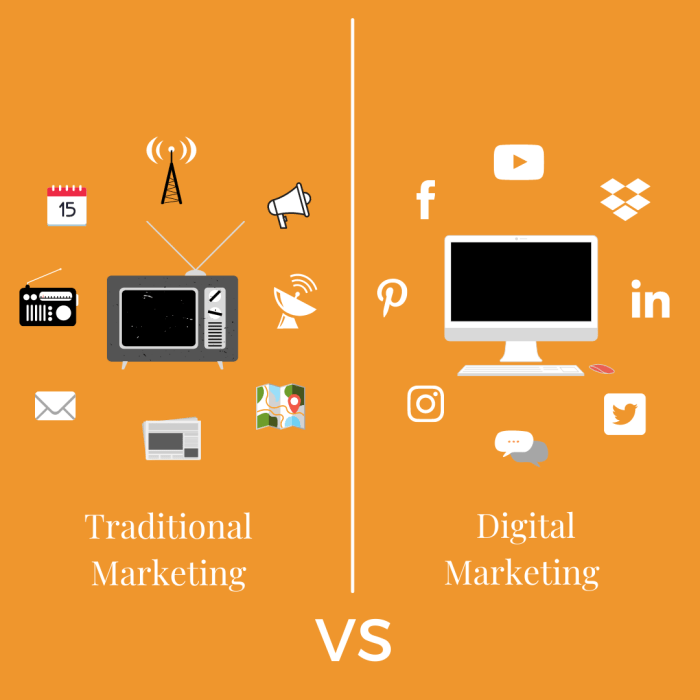
Embark on a journey through the realms of traditional and digital advertising campaigns, exploring their nuances and impact on consumer behavior.
Discover the key disparities between these two marketing strategies and delve into real-world examples showcasing their effectiveness.
Traditional vs Digital Advertising Campaigns
Traditional advertising campaigns involve using traditional media channels such as television, radio, print, and billboards to reach a broad audience. On the other hand, digital advertising campaigns utilize online platforms like social media, websites, search engines, and mobile apps to target specific demographics.
Examples of Traditional vs Digital Advertising Methods
Traditional Advertising Methods:
- Newspaper ads
- TV commercials
- Billboards
Digital Advertising Methods:
- Social media ads
- Google AdWords
- Email marketing
Advantages and Disadvantages of Traditional vs Digital Advertising Campaigns
Advantages of Traditional Advertising Campaigns:
- Wide reach to a large audience
- Established credibility and trust with older demographics
- Tangibility with physical ads like brochures and billboards
Disadvantages of Traditional Advertising Campaigns:
- Higher cost compared to digital ads
- Limited targeting capabilities
- Harder to measure ROI accurately
Advantages of Digital Advertising Campaigns:
- Precise targeting based on demographics, behaviors, and interests
- Cost-effective compared to traditional methods
- Real-time tracking and analytics for performance evaluation
Disadvantages of Digital Advertising Campaigns:
- Highly competitive landscape online
- Ad blockers can hinder reach
- Constant need for optimization due to algorithm changes
Traditional Advertising Campaigns
Traditional advertising campaigns have been a staple in the marketing industry for decades, offering a variety of ways to reach target audiences effectively. While digital advertising has gained popularity in recent years, traditional methods still play a crucial role in reaching certain demographics and creating brand awareness.
Effectiveness of Traditional Advertising Campaigns
Traditional advertising campaigns have proven effective in reaching target audiences, especially those who may not be as active online or who prefer more traditional forms of media consumption. These campaigns can help businesses establish a presence in the market and build credibility among consumers.
Common Types of Traditional Advertising Channels
- TV Advertising: Television commercials have long been a popular way to reach a wide audience quickly and effectively.
- Radio Advertising: Radio ads are a cost-effective way to target specific demographics based on listening preferences.
- Print Advertising: Print ads in newspapers, magazines, and direct mail can provide a tangible and long-lasting impression on consumers.
- Outdoor Advertising: Billboards, bus stop ads, and other outdoor mediums can reach audiences in high-traffic areas.
Creating Brand Awareness and Customer Loyalty
Traditional advertising campaigns play a crucial role in creating brand awareness by exposing consumers to a brand repeatedly through various channels. This repetition helps establish brand recognition and recall. Additionally, traditional advertising campaigns can help foster customer loyalty by building trust and credibility over time.
Digital Advertising Campaigns

When it comes to digital advertising campaigns, their impact on consumer behavior and purchasing decisions is undeniable. With the rise of the internet and technology, digital advertising has become a powerful tool for businesses to reach their target audience and influence their decisions.
Social Media Advertising
Social media platforms like Facebook, Instagram, Twitter, and LinkedIn offer a great opportunity for businesses to connect with their customers on a personal level. Through targeted ads and sponsored content, companies can engage users based on their interests, demographics, and online behavior.
- Facebook Ads: With advanced targeting options and a large user base, Facebook ads allow businesses to reach a specific audience and drive conversions.
- Instagram Stories: Utilizing the visual appeal of Instagram stories, businesses can create engaging ads to promote their products or services.
Search Engine Marketing
Search engine marketing (SEM) involves promoting websites by increasing their visibility in search engine results pages through paid advertising. This type of digital advertising is crucial for businesses looking to boost their online presence and attract potential customers.
- Google Ads: With Google’s dominance in the search engine market, Google Ads is a popular choice for businesses to display their ads on relevant search results pages.
- Targeting: By targeting specific s related to their business, companies can increase their chances of appearing in search results when users are looking for relevant products or services.
Display Advertising
Display advertising involves creating visual ads that are displayed on websites, apps, or social media platforms to reach a wider audience. These ads can be in the form of banners, videos, or interactive multimedia content.
- Retargeting Ads: By targeting users who have previously visited their website, businesses can remind them of products they viewed or abandoned in their shopping cart, increasing the likelihood of conversion.
- Native Advertising: Integrating ads seamlessly into the content of a website or platform can improve user experience and lead to higher engagement rates.
Email Marketing
Email marketing remains a highly effective digital advertising strategy for businesses to communicate with their customers directly. Through personalized email campaigns, companies can promote their products, share updates, and build relationships with their target audience.
- Automation: Using email marketing automation tools, businesses can send targeted emails based on user actions or preferences, increasing the relevancy and effectiveness of their campaigns.
- Segmentation: By segmenting their email list based on demographics, behavior, or purchase history, companies can tailor their messages to specific groups of customers for better results.
Advertising Campaign Services

Advertising campaigns play a crucial role in promoting a business’s products or services to its target audience. The process of developing an advertising campaign involves various stages, from conceptualization to execution, to ensure its effectiveness.
Advertising agencies are key players in creating and managing advertising campaigns. These agencies have the expertise and resources to develop creative strategies, design compelling content, and deploy campaigns across different platforms to reach the target audience effectively.
Businesses can measure the success of their advertising campaigns through various metrics such as reach, engagement, conversions, and return on investment (ROI). By analyzing these metrics, businesses can optimize their advertising campaigns for better results, making necessary adjustments to improve performance and achieve their goals.
Role of Advertising Agencies
- Advertising agencies help businesses identify their target audience and develop strategies to reach them effectively.
- These agencies create compelling content and visuals that resonate with the target audience and communicate the brand message effectively.
- They deploy the advertising campaigns across various channels such as television, radio, print, digital, and social media to maximize reach and engagement.
- Advertising agencies track the performance of the campaigns and make data-driven decisions to optimize them for better results.
Measuring Advertising Campaign Success
- Reach: The number of people exposed to the advertising campaign.
- Engagement: The level of interaction and interest generated by the campaign among the target audience.
- Conversions: The number of desired actions taken by the audience as a result of the campaign, such as making a purchase or signing up for a service.
- Return on Investment (ROI): The ratio of the revenue generated to the cost of the campaign, indicating the profitability of the advertising efforts.
In conclusion, the debate between traditional and digital advertising campaigns remains a pivotal aspect of modern marketing strategies, each offering unique advantages and challenges.
Essential FAQs
How do traditional advertising campaigns differ from digital ones?
Traditional campaigns rely on offline channels like TV and radio, while digital campaigns leverage online platforms such as social media and email marketing.
What are the advantages of using traditional advertising methods?
Traditional methods can reach a broader audience and create a tangible brand presence through mediums like print and outdoor advertising.
How can businesses measure the success of their digital advertising campaigns?
Metrics like click-through rates, conversion rates, and engagement levels help businesses evaluate the effectiveness of their digital campaigns.





